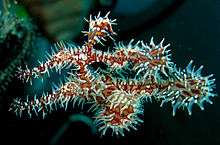Solenostomus
| Ghostpipefish Temporal range: 55.8–0 Ma | |
|---|---|
 | |
| Solenostomus paradoxus | |
| Scientific classification | |
| Kingdom: | Animalia |
| Phylum: | Chordata |
| Class: | Actinopterygii |
| Order: | Syngnathiformes |
| Family: | Solenostomidae Bonaparte, 1846 |
| Genus: | Solenostomus Lacépède, 1803 |
| Species | |
|
See text | |
Solenostomus, also known as ghost pipefishes, false pipefishes or tubemouth fishes, is a genus of fishes in the order Syngnathiformes. Solenostomus is the only genus in the family Solenostomidae, and includes six currently recognized species.[2] Ghostpipefishes are related to pipefishes and seahorses. They are found in tropical waters of the Indian Ocean, from Asia to Africa.[3]
The animals, none of which are longer than 15 centimetres (5.9 in), float near motionlessly, with the mouth facing downwards, around a background that makes them nearly impossible to see. They feed on tiny crustaceans, sucked inside through their long snout. They live in open waters except during breeding, when they find a coral reef or muddy bottom, changing color and shape to minimize visibility.[3]
In many respects, they are similar to the pipefishes, but can be distinguished by the presence of pelvic fins, a prominent, spiny, dorsal fin, and star-shaped plates on the skin. Unlike true pipefish, female ghostpipefishes use their enlarged pelvic fins to brood their eggs until they hatch.[3]

Species
- Solenostomus armatus M. C. W. Weber, 1913 (long-tailed ghost pipefish or armored pipefish)
- Solenostomus cyanopterus Bleeker, 1854 (robust ghost pipefish)
- Solenostomus halimeda J. W. Orr, Fritzsche & J. E. Randall, 2002 (Halimeda ghost pipefish)
- Solenostomus leptosoma S. Tanaka (I), 1908 (delicate ghost pipefish)
- Solenostomus paegnius Jordan & Thompson, 1914 (roughsnout ghost pipefish)
- Solenostomus paradoxus (Pallas, 1770) (ornate ghost pipefish or harlequin ghost pipefish)
| Wikimedia Commons has media related to Solenostomus. |
References
- ↑ Sepkoski, Jack (2002). "A compendium of fossil marine animal genera". Bulletins of American Paleontology. 364: 560. Retrieved 8 January 2008.
- ↑ Family Solenostomidae FishBase. Accessed 1 February 2015.
- 1 2 3 Orr, J.W. & Pietsch, T.W. (1998). Paxton, J.R. & Eschmeyer, W.N., eds. Encyclopedia of Fishes. San Diego: Academic Press. p. 169. ISBN 0-12-547665-5.
- "Solenostomus". Integrated Taxonomic Information System. Retrieved 6 June 2006.
- Tim Flannery and Peter Schouten. Amazing Animals: Extraordinary Creatures and the Fantastic Worlds They Inhabit. New York: Atlantic Monthly Press, 2004. Page 116-117.
- Orr, JW and Fritzsche, RA. 1993. Revision of the Ghost Pipefishes, Family Solenostomidae (Teleostei: Syngnathoidei). Copeia 1993:168-182.
External links
- Photos of the 5 different species of Ghostpipefishes
- 55 photos of different Ghostpipefishes species
- Video of different species of Ghostpipefishes